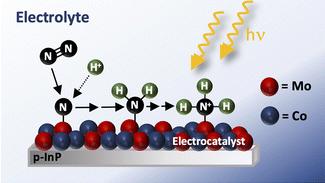Manpreet Kaur, Marc Walker, Steven Hindmarsh, Charlotte Bolt, Stephen York, Yisong Han, Martin R. Lees and Katharina Brinkert
Faraday Discussions Advance Article (2023)
doi: 10.1039/D2FD00157H, preprint available open access: doi: 10.48550/arXiv.2305.06877
Efficient artificial photosynthesis systems are currently realized as catalyst- and surface-functionalized photovoltaic tandem-and triple-junction devices, enabling photoelectrochemical (PEC) water oxidation while simultaneously recycling CO2 and generating hydrogen as a solar fuel for storable renewable energy. Although PEC systems also bear advantages for the activation of dinitrogen – such as a high system tunability with respect to the electrocatalyst integration and a directly controllable electron flux to the anchoring catalyst through the adjustability of incoming irradiation – only a few PEC devices have been developed and investigated for this purpose. We have developed a series of photoelectrodeposition procedures to deposit mixed-metal electrocatalyst nanostructures directly on the semiconductor surface for light-assisted dinitrogen activation. These electrocatalyst compositions containing Co, Mo and Ru in different atomic ratios follow previously made recommendations of metal compositions for dinitrogen reduction and exhibit different physical properties. XPS studies of the photoelectrode surfaces reveal that our electrocatalyst films are to a large degree nitrogen-free after their fabrication, which is generally difficult to achieve with traditional magnetron sputtering or e-beam evaporation techniques. Initial chronoamperometric measurements of the p-InP photoelectrode coated with the Co–Mo alloy electrocatalyst show higher photocurrent densities in the presence of N2(g) than in the presence of Ar at −0.09 V vs. RHE. Indications of successful dinitrogen activation have also been found in consecutive XPS studies, where both N 1s and Mo 3d spectra reveal evidence of nitrogen–metal interactions.
© The Royal Society of Chemistry 2023

